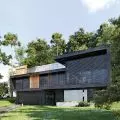On January 27, the District Museum in Bydgoszcz opens the exhibition "Identity. 100 Years of Polish Architecture." This is the second installment of the National Institute of Architecture and Urbanism's exhibition project, in which curators from six cities look at the post-1918 architectural phenomenon in Poland.
In 2019, snippets of the history of five cities - Krakow, Warsaw, Lublin, Poznań and Katowice - were analyzed. This time, NIAiU has invited the regional chapters of the Association of Polish Architects in Bydgoszcz, Łódź, Szczecin, Gdańsk, Olsztyn and Radom to join the ever-present discussion. Together with local curators, the organizers are looking at changes in the architectural landscape and defining the identity of the following six cities. The exhibitions are the result of a discussion about the ongoing changes in Polish architecture and urban planning of the last century. The intention of the organizers is not only to promote Polish architectural culture, but also to invite reflection on our environment and the quality of the space in which we live.
mock-ups and drawings
The exhibition will feature architectural drawings, contemporary and archival photographs, texts and mock-ups. Each of the subsequent regional installments will be accompanied by a program of accompanying events.
history of Bydgoszcz
On January 27, the first exhibition of this year's edition will open in Bydgoszcz. The architecture of Bydgoszcz of the last hundred years reflects the transformations that took place in the national and social structures of the city. From a bourgeois and German "kleine Berlin" Bydgoszcz became a Polish city, experiencing dynamic spatial and infrastructural development.
Before World War II there was intensive development of industrial buildings (power plant, "Kabel" factory), housing (tenement houses), public buildings (bus station, city hospital, regatta course, city stadium, churches). As in many other centers, modernism and functionalism dominated, although in some buildings one can find clear references to historical styles.
icons of modernity
Photo: NIAiU
After World War II, in addition to buildings typical of an industrial and artisan center, cultural, educational and business facilities played a significant role in the public space, testifying to the transformation of the city's character in the following decades. Thus, the architectural dominants of the city became the Pomeranian Philharmonic and Opera Nova, university buildings, banks. Turning to the river, binding the past with modernity are the qualities of the modern image of the city, in whose architecture we find both testimonies of its interesting history and the modern face of Poland's eighth largest city.
practical information
Duration: 27.01-31.03 2022
vernissage 27.01, at 18.00
Location
Leon Wyczółkowski District Museum in Bydgoszcz
Main Building, 4 Gdańska St.
Opening hours
Tuesday, Thursday: 10 am - 6 pm
Wednesday, Friday: 12-8pm
Saturday-Sunday: 12-18
Monday: closed
colophon
Organizer: National Institute of Architecture and Urbanism
Co-organizer: District Museum in Bydgoszcz
Scientific curator: dr hab. inż. arch. Bolesław Stelmach, prof. of PŁ
Curatorial team:
Małgorzata Jędrzejczyk - Cracow
Grzegorz Mika - Warsaw
Marcin Semeniuk, Karol Krupa - Lublin
Alicja Gzowska - Poznań
Jakub Świerzawski - Katowice
Jacek Wiśniewski - Bydgoszcz
Coordination: Weronika Soltysiak
Production: Dominika Dragan-Alcantara
Partners: SARP Bydgoszcz Branch, DS Smith, Partners Studio
Media Patrons: Architektura Murator, Architektura&Biznes, TVP 3 Bydgoszcz, Polskie Radio PIK.
Co-financed by the Ministry of Culture and National Heritage
Cardboard for the exhibition elements was produced at DS Smith Polska



































